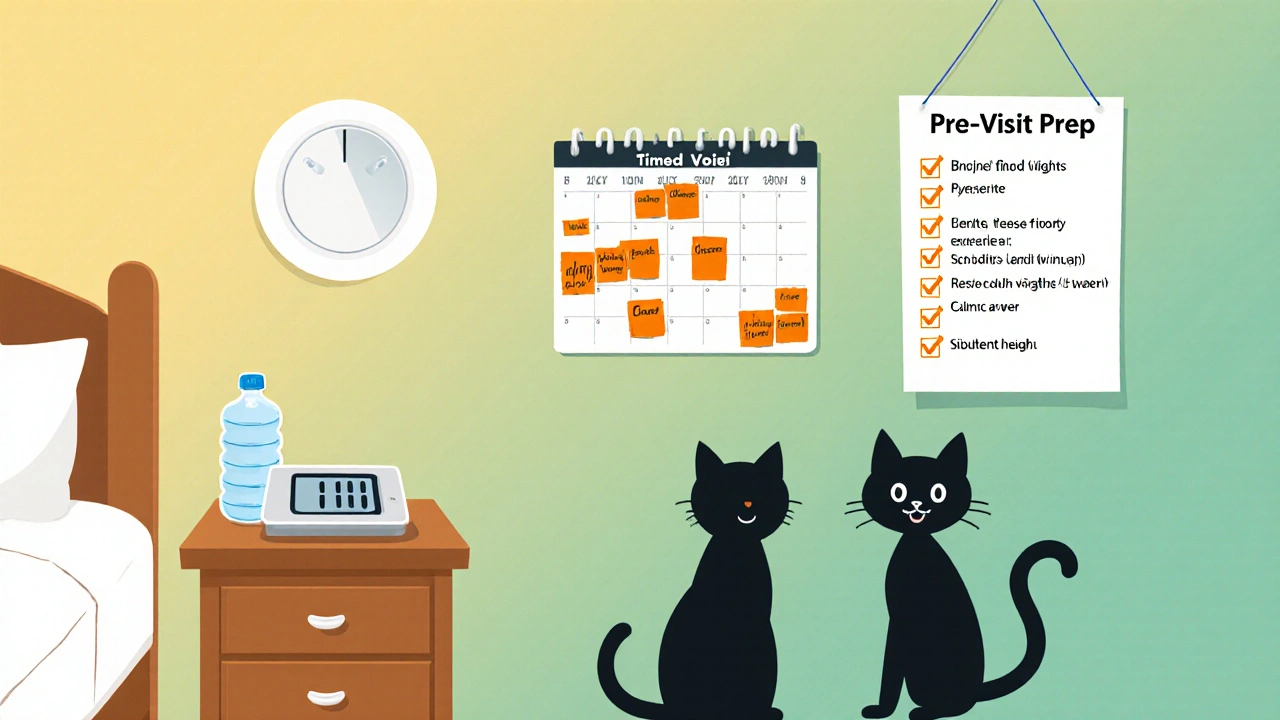Fluid Balance Tracker
Daily Fluid Balance Calculator
Track your fluid intake, urine output, and weight to monitor for potential dehydration or electrolyte imbalances after brain surgery or trauma.
Fluid Balance Summary
Critical MetricsQuick Takeaways
- Post‑operative polyuria and neurogenic bladder are the most common reasons for a sudden boost in bathroom trips after head injury or surgery.
- Hormone imbalances like ADH deficiency, diabetes insipidus, and cerebral salt‑wasting can mimic each other - proper labs are essential.
- Track fluid intake, weight, and urine volume daily; a bladder diary often reveals patterns doctors can act on.
- Short‑term catheter use, timed voiding, and anticholinergic meds help control urgency while the nervous system heals.
- Call a urologist or return to the ER if you notice fever, foul‑smelling urine, or a sudden drop in urine output.
After a craniotomy or a serious head knock, many patients notice they’re running to the bathroom far more often than before. That surge isn’t just inconvenient - it can signal underlying problems that, if ignored, may delay recovery or cause new complications. Below we unpack why the brain’s trauma can hijack the bladder, how clinicians pinpoint the cause, and what practical steps you can take at home to stay in control.
Postoperative polyuria is a medical term that describes an unusually high urine output (more than 3 L per day) occurring after neurosurgery or brain trauma. It often stems from disruptions in the brain’s water‑balance circuitry, especially the hypothalamus and pituitary gland. When this system falters, the kidneys receive the wrong signals and dump excess fluid.
Another frequent culprit is neurogenic bladder, a condition where nerve damage interferes with the bladder’s ability to store or release urine properly. Depending on where the injury lies, the bladder may become overactive (spastic) or underactive (flaccid), both of which can lead to frequent trips or retention.
Why the Brain Controls the Bladder
The brain’s hypothalamus releases antidiuretic hormone (ADH), also called vasopressin, which tells the kidneys to re‑absorb water. A skull fracture, swelling, or surgical manipulation can damage the hypothalamic‑pituitary axis, dropping ADH levels and triggering a condition called central diabetes insipidus. In contrast, cerebral salt‑wasting syndrome forces the kidneys to lose both salt and water, also resulting in high urine output but through a different mechanism.
Traumatic brain injury (TBI) often adds another layer: swelling (cerebral edema) raises intracranial pressure, which can compress the pathways that coordinate bladder emptying. The net effect is a mix of hormonal imbalance and disrupted neural control - the perfect storm for increased urination.
How Doctors Diagnose the Problem
- Lab tests: Blood sodium, osmolality, and ADH levels help differentiate diabetes insipidus from salt‑wasting.
- Urine studies: Measuring urine specific gravity and osmolality indicates how concentrated the urine is.
- Imaging: CT or MRI can reveal edema, bleed, or surgical sites impinging on the bladder‑control centers.
- Bladder diary: Patients log fluid intake, urine volume, and timing for at least 48 hours. This simple tool often uncovers patterns that guide treatment.
- Urology consult: A specialist may perform a post‑void residual (PVR) scan to see if the bladder empties completely.
Early detection matters because untreated hormone imbalances can lead to severe dehydration, electrolyte disturbances, or even seizures.

Managing the Symptoms at Home
- Fluid balance monitoring: Weigh yourself daily and record total fluid intake. Aim for a stable weight; a sudden drop of more than 2 kg in 24 hours signals excessive loss.
- Timed voiding: Set a schedule (e.g., every 2‑3 hours) rather than waiting for the urge. This reduces urgency‑driven accidents.
- Use a bladder diary: Note times, volumes, and any associated symptoms (headache, dizziness). Share it with your care team.
- Short‑term catheterization: If the bladder cannot empty fully, a nurse‑inserted Foley catheter may be used for a few days under strict hygiene to prevent infection.
- Medication options: Anticholinergic drugs (e.g., oxybutynin) calm an overactive bladder, while desmopressin replaces missing ADH in central diabetes insipidus.
- Electrolyte replacement: Oral rehydration solutions or prescribed saline IVs can correct sodium loss from cerebral salt‑wasting.
- Physical therapy: Gentle pelvic floor exercises strengthen bladder control once the nervous system stabilizes.
When to Call a Professional
- Fever, chills, or foul‑smelling urine - signs of a urinary tract infection (UTI).
- Sudden drop in urine output (less than 0.5 L/day) - could mean the kidneys are shutting down.
- Severe headache, confusion, or seizures - may indicate worsening intracranial pressure.
- Persistent electrolyte abnormalities despite treatment.
These red flags warrant an immediate return to the hospital or urgent contact with your neurosurgeon.

Key Differences: Diabetes Insipidus vs. Cerebral Salt‑Wasting
| Feature | Central Diabetes Insipidus | Cerebral Salt‑Wasting Syndrome |
|---|---|---|
| Primary hormone affected | Low ADH (vasopressin) | Excess natriuretic peptide activity |
| Urine osmolality | Low (<300 mOsm/kg) | Low to normal |
| Serum sodium | Normal or low | Often low (<135 mmol/L) |
| Response to desmopressin | Positive - urine concentrates | None - does not help |
| Treatment focus | ADH replacement, fluid restriction | Salt and volume replacement, fludrocortisone |
Practical Checklist Before Your Follow‑up Appointment
- Bring your bladder diary (at least 48 hours).
- List all medications, including over‑the‑counter pain relievers.
- Record daily weights and any episodes of dizziness.
- Note any infections (fever, chills) or changes in urine color/smell.
- Prepare questions about hormone testing, catheter care, and long‑term bladder training.
Frequently Asked Questions
Why does my urine volume suddenly increase after brain surgery?
The surgery can disrupt the hypothalamic‑pituitary axis, lowering ADH levels and causing the kidneys to release more fluid. Swelling or nerve damage may also impair bladder control, leading to frequent voiding.
Is it normal to need a catheter after a head injury?
A short‑term Foley catheter is sometimes used if the bladder does not empty fully. It’s not a permanent solution, and strict hygiene is crucial to avoid a urinary tract infection.
Can lifestyle changes help reduce the urgency?
Yes. Maintaining a consistent fluid schedule, avoiding caffeine/alcohol, and doing timed voiding exercises can lessen urgency. Pelvic floor strengthening under physical‑therapy guidance also supports bladder control.
What is the difference between diabetes insipidus and cerebral salt‑wasting?
Both cause high urine output, but diabetes insipidus stems from low ADH and responds to desmopressin, while cerebral salt‑wasting results from excess salt loss and is treated with saline and mineralocorticoids. Lab values and response to medication help differentiate them.
When should I be worried about dehydration?
If you lose more than 2 kg (about 4.5 lb) in a day, feel dizzy, have dry mouth, or notice dark urine, dehydration may be setting in. Contact your medical team promptly.







Avril Harrison
October 18, 2025 AT 20:57Just a heads‑up that the way hospitals handle post‑op bladder issues can vary a lot between the UK and the US, so if you’re reading this from abroad, check what local protocols say. It’s useful to ask the nurse about their routine for timed voiding – they might have a slightly different schedule that works better for you.
Sarah Hanson
October 20, 2025 AT 09:04While the information presented is thorough, I would politely recommend that patients also consider coordinating with a dietitian to ensure electrolyte balance; this collaboration often mitigates complications that arise from polyuria.
Nhasala Joshi
October 21, 2025 AT 18:24🚨🚨Listen up: the real agenda behind "quick takeaways" is to keep us complacent while big pharma pushes secret‑stroke‑bladder‑drugs 🍭🧪. The neuro‑endocrine axis is being weaponised – ADH suppression is no accident! Stay woke, log every drop, and question every "clinical" recommendation 😈💧.
Karla Johnson
October 23, 2025 AT 00:57When dealing with postoperative polyuria, the first principle is to establish a reliable baseline of fluid intake and output, because without accurate data any intervention is just guesswork. Start by recording the exact volume of each void in a dedicated notebook or a digital spreadsheet; consistency matters more than the medium.
Next, weigh yourself each morning after voiding – a sudden loss of even a kilogram can signal dangerous dehydration that the brain may not notice.
Correlate those weight changes with the urine volume; if you’re losing three liters a day and dropping weight, you’re likely experiencing central diabetes insipidus rather than simple overhydration.
In that scenario, desmopressin becomes the cornerstone therapy, but only after confirming low plasma osmolality and low ADH levels via lab work – never self‑medicate.
If the labs point toward cerebral salt‑wasting, the treatment paradigm flips to aggressive sodium repletion, often with hypertonic saline under ICU supervision; this is a completely different path and the two conditions are not interchangeable.
Meanwhile, timed voiding schedules can reduce urgency‑driven accidents; set a timer for every two to three hours and stick to it, regardless of the sensation.
For patients with neurogenic bladder, a bladder diary can reveal residual volumes that suggest incomplete emptying, prompting a short‑term catheter or intermittent self‑catheterization under strict aseptic technique.
Anticholinergic agents like oxybutynin may calm an overactive bladder, but they can also exacerbate dry mouth and constipation, so monitor side effects closely.
Electrolyte panels should be checked daily – sodium, potassium, and chloride trends will guide whether you need oral rehydration solutions or intravenous replacement.
Physical therapy isn’t just for the limbs; pelvic floor strengthening can improve bladder control once neural pathways start to recover, and it’s something you can begin with gentle Kegel exercises.
Always keep an eye out for red‑flag symptoms: fever, foul‑smelling urine, sudden drops in output, or worsening headaches – these warrant immediate medical attention.
Finally, communicate all findings to your neurosurgeon and urologist; a multidisciplinary approach ensures that hormonal, neural, and renal aspects are all addressed in concert.
Remember, vigilance and structured self‑monitoring are the best allies in navigating the complex aftermath of brain surgery or trauma.
Linda A
October 24, 2025 AT 04:44In the quiet moments between appointments, one might reflect on the delicate dialogue between brain and bladder – a conversation we often take for granted until it falters. The loss of that equilibrium feels like an existential whisper, urging the patient to confront the fragility of bodily sovereignty.
Joe Moore
October 25, 2025 AT 05:44Ayla Stewart
October 26, 2025 AT 02:57I’m curious about the practical steps for timing voids without feeling like a clock‑watcher – any simple routine works best?
Stephanie Zaragoza
October 26, 2025 AT 22:24Firstly, the article is comprehensive; however, the patient must not overlook the importance of daily electrolyte monitoring-especially serum sodium, which can fluctuate dramatically! Secondly, while timed voiding is beneficial, it should be paired with a strict fluid‑intake log; otherwise, the strategy loses efficacy. Thirdly, any introduction of anticholinergic medication demands vigilant observation for side‑effects-dry mouth, constipation, and potential cognitive impact-particularly in post‑operative patients!
James Mali
October 27, 2025 AT 15:04🤷♂️
Janet Morales
October 28, 2025 AT 04:57While the previous comment obsessively lists precautions, the reality is that over‑monitoring can paralyze recovery-patients need to breathe, not constantly tally numbers. The truly vital part is trusting your body’s signals and seeking help only when red flags appear, not at every minor deviation.